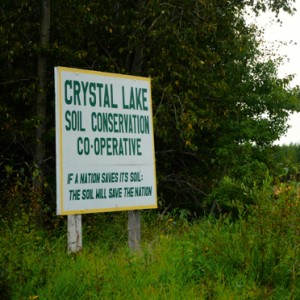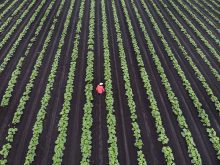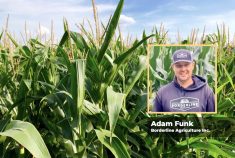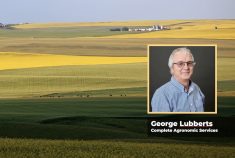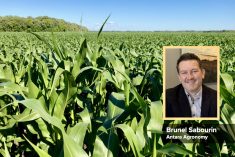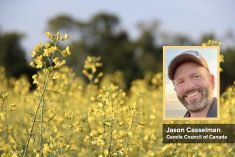Farmers make this kind of discovery all the time, but for Washington State geology professor, David Montgomery, it was a big lesson about soil when he and his wife moved to a new house in north Seattle some eight years ago. Their new lawn was a sparse and ratty patch of grass trying to thrive in a soil that had been so beaten and abused, it could hardly sustain anything green.
As soils go, this one was essentially dead.
“My wife is a gardener,” Montgomery says. “She wanted to grow a lot of plants in the yard so she started aggressively adding compost and mulching everything to bring the soil back to life.”
Read Also

Could crop sharing be a viable option for your farm?
Crop sharing could be a good option for young and beginning farmers.
Now Montgomery likes to show off a current picture of that soil profile, and it’s astonishing. Sitting on top of that dead zone are two inches of beautiful, dark topsoil.
Building two inches of soil in under a decade is incredibly fast for one of Earth’s more complex geologic processes. Any geologist will tell you that if you grind rock into a powder, mix in some water, and then add billions of organisms, this will make you a fine farming soil.
Except it needs one more thing: time. Sometimes it takes a few thousand years before it’s ready to come out of the oven.
“It got me wondering,” Montgomery says of his backyard experience. “Can we rebuild soil faster than nature does it?”
His wife’s labours suggest the answer is “yes,” which is a good thing. There’s no question that agriculture can be pretty tough on the soil, especially after a century or more.
Civilizations rise on the quality of their soil, and they fall as their soil burns out, and to date, humanity has never been able to get around it.
“A fundamental condition for sustaining a civilization is sustaining the soil,” Montgomery agrees. “Archeological studies show that soil erosion played a role in the demise of many cultures around the world including the ancient civilizations in Neolithic bronze age Europe and classical Greece.”
North America suffered a major scare during the dust bowl of the 1930s when searing drought, high winds and the farming techniques of the times combined for a major topsoil blowout. But we learned fast and over the next several decades we lessened and eliminated tillage, we bred crops that were better suited to certain geographies and we developed a panoply of chemistries that made crop production efficient and profitable.
- More Country Guide: Shelterbelts: a habitat for beneficial insects
We also know a lot more about soil now. The earliest farmers looked upon soil as a deity to be worshipped, and it wasn’t until the Renaissance that we started to look at soil as a decipherable mystery.
Leonardo da Vinci observed that we know more about the movement of celestial bodies than the soil underfoot. Unlike the cosmos, where the motion of the stars is right there in front of you, the soil remains dark and covered, its secrets observable only if we pull it apart, figure out how the different components work, and then put them back together to see how they work as a complete system.
As we learned more about soil we found that it’s more than a substrate in which plants grow. Soil is both living and dead, with mineral particles providing space and nutrients to a teeming world of living organisms from bacteria to earthworms, from several species of fungi to a variety of digging mammals. In its natural state, soil is a living system, powered by solar energy delivered as carbohydrates by the plants growing in it. Soil is the ultimate recycling mill where entire casts of organisms go to work on dead tissue, feeding on it, breaking it up and then recombining it into a catalogue of nutrients for plants, animals and microbes.
“The work that’s gone on in terms of symbioses between microbes, bacteria and fungi living in the soil and nutrient transfer into plants in the last couple of decades has been amazing,” Montgomery says. “It’s changing the way we think about soil fertility and how we actually understand soil ecology. It leads me to think that soil ecology is actually the frontier and future of agriculture.”
If Montgomery’s wife can revitalize her lawn by incorporating organic matter and kick-starting the soil biota, can we do the same with farming? Can we use our greater understanding of soil science and put soil organisms to work mineralizing nutrients for crops and can we use crop rotations to put roots in the ground to energize the living soil? In short, can we both grow crops and build up soil organic matter?
The answer is an unqualified maybe, but a good starting point is to look at natural grassland soils and how they work.
“I think that natural systems are a very good reference for us although we have to be cautious about how we interpret those systems,” says University of Manitoba soil scientist Don Flaten. “Some of our long-term efforts have been driven toward natural systems agriculture and how to employ sound ecological principles to try to mimic the success of natural ecosystems wherever possible.”
The old grasslands of the North American Great Plains were vast expanses of mixed stands of different species, most of them perennials. The soil had a blanket of decaying litter and living plants whose roots drilled down into the mineral substrate, opening pores and channels into which water permeated. Soil organisms cycled nutrients through an enormous barter system by which they provided nutrients to the plants while the plants provided photosynthetic energy to the soil organisms. The soil was dark and rich in organic matter. Above ground this fed the wandering grazers like bison and elk that, in turn, fed an ecosystem of predators and recycled nutrients back into the soil.
Our agricultural fields work differently. They’re monocultural carpets of annual colonizers dependent on soil disturbance to provide them with their ideal habitat. They tend to leave regular patches of open soil. They don’t root deeply, and they use most of their photosynthetic energy to produce seeds. It’s a greatly simplified world and the underground ecosystems reflect that simplicity. They’re less diverse and, although it’s a very productive system in terms of our food and fibre, it’s a less stable system, susceptible to soil erosion, rapid nutrient loss and the loss of organic matter.
“In the late 20th Century about a third of the carbon that’s been added to the atmosphere didn’t come out of a smokestack or a tailpipe,” Montgomery says. “It came out of the soil from degraded soil organic matter and, if that much carbon came out of the world’s soils, you could make a pretty good argument that you could put it back.”
What Montgomery is suggesting is nothing short of global soil restoration, bringing back the rich grassland soils and conserving nutrients while still maintaining the productivity of the modern farm. It’s a steep order, the ultimate example of thinking globally and acting locally.
There are precedents though. Conservation tillage and zero tillage, methods of soil conservation that keep roots in the ground and soil protecting stubble on the post-harvest fields are now common practices.
They’re also important steps in what we’re now calling conservation agriculture: minimizing mechanical disturbance of the soil and protecting the soil with a permanent cover of organic material and running rotations of at least two crops. We’ve seen damaged soil rebounding as a consequence of low tillage. Are there other things that we could do?
“There’s a whole bunch of things we need to do,” says University of Manitoba soil ecologist Mario Tenuta. “One is the proper nutrition of crops with synthetic fertilizers or organic products such as manures. You can increase the organic matter in soil by growing crops with more biomass or residues returned to soil, and that would build organic matter levels.”
If possible, farmers could rotate to perennials, an old pre-Green Revolution trick that worked well to stabilize the ground and pump organic nitrogen into the soil. Under ideal conditions, the grazers could eat the forage where it stands, saving the farmer the time and cost of baling as well as transporting the forage. The animals do it for you. Additionally, many of the nutrients are cycled back into the soil in much the same way that the old grassland and ruminant ecosystems worked.
“If they’re grazing, the phosphorus cycle is pretty tight,” Tenuta says. “Animals just excrete and the phosphorus is still there. The phosphorus the animal puts in the bone and the meat only amounts to a few pounds coming off the field every year and compared to cropping, it’s a much lower removal.”
Tenuta mentions other benefits such as breaking certain plant disease cycles and increasing rotational diversity. Plus, if it’s a perennial legume, there’s the added nitrogen and a buildup of carbon in the soil.
There’s another way to get carbon back in the ground and it’s a method that was used by the people of the Amazon Basin on the Terra Preta soils before the Europeans arrived. They produced charcoal by burning their organic trash in a low-oxygen environment, and they worked the charcoal into their soils.
“That way you can sequester carbon in a form that doesn’t decompose very fast and you get energy out of the combustion process at the same time,” Montgomery says. “In other words you can generate a carbon negative energy source that will actually build organic carbon in the soil. It’s another piece in the tool kit not only for addressing climate change but for restoring fertility to some of the world’s degraded soils.”
Although putting carbon back in the soil sounds simple, rejuvenating a complex system on a field-by-field basis is very complicated. Tenuta points out that any soil system, even the natural ones, still have a net movement of nutrients downhill and into the oceans. If we’re really serious about soil conservation then we, as a society, have to come up with ways to recapture nutrients from sewage and recycle them back to the farm.
“The nutrients we remove end up going to human food or they’re going to end up going to animal food,” Tenuta says. “Now the excretion products of those animals or those humans need to go back to the land, particularly for phosphorus.”
It’s a very large problem and no one thinks there are simple solutions. At the regional level, both farmers and soil scientists will agree that these things are dependent on local conditions. It depends on what type of operation a farmer runs, where it’s located, the weather and soil type. Flaten reminds us that there’s a tremendous amount of variation.
“It may be within one field,” Flaten explains. “If you have a more rolling topography, a pothole there may be wetter than any part of the Red River Valley and a hilltop may be drier than Medicine Hat. This variability occurs at a variety of different scales, from the regional scale down to the metre scale within a field. That’s why we just have to be very cautious about making broad generalizations.”
But he concedes that we really need to care about soil conservation and we need to embrace the ethic of conservation and adopt beneficial practices that farmers know will work on their land. We need to encourage, enable and reward people who employ the soil conservation ethic.
Montgomery says that it’s not just up to farmers. “I’m really impressed that conservation agriculture is essentially driven from farmers up, but it should be supported at all levels. Governments worldwide should be supporting adoption of these methods aggressively,” Montgomery says. “It really is one of the most fundamental things that humanity needs to do over the next 100 years. We’ve got to get it right.”


